Factors Impacting Restaurant Customer Choices
VerifiedAdded on 2020/02/24
|14
|3377
|280
Literature Review
AI Summary
This literature review examines the various factors that influence customers' choices when selecting a restaurant. It discusses consumer behavior models, the importance of food quality, and the impact of demographic and psychological factors on dining decisions. The research highlights the need for restaurant owners to adapt their strategies based on customer preferences and the evolving market landscape.
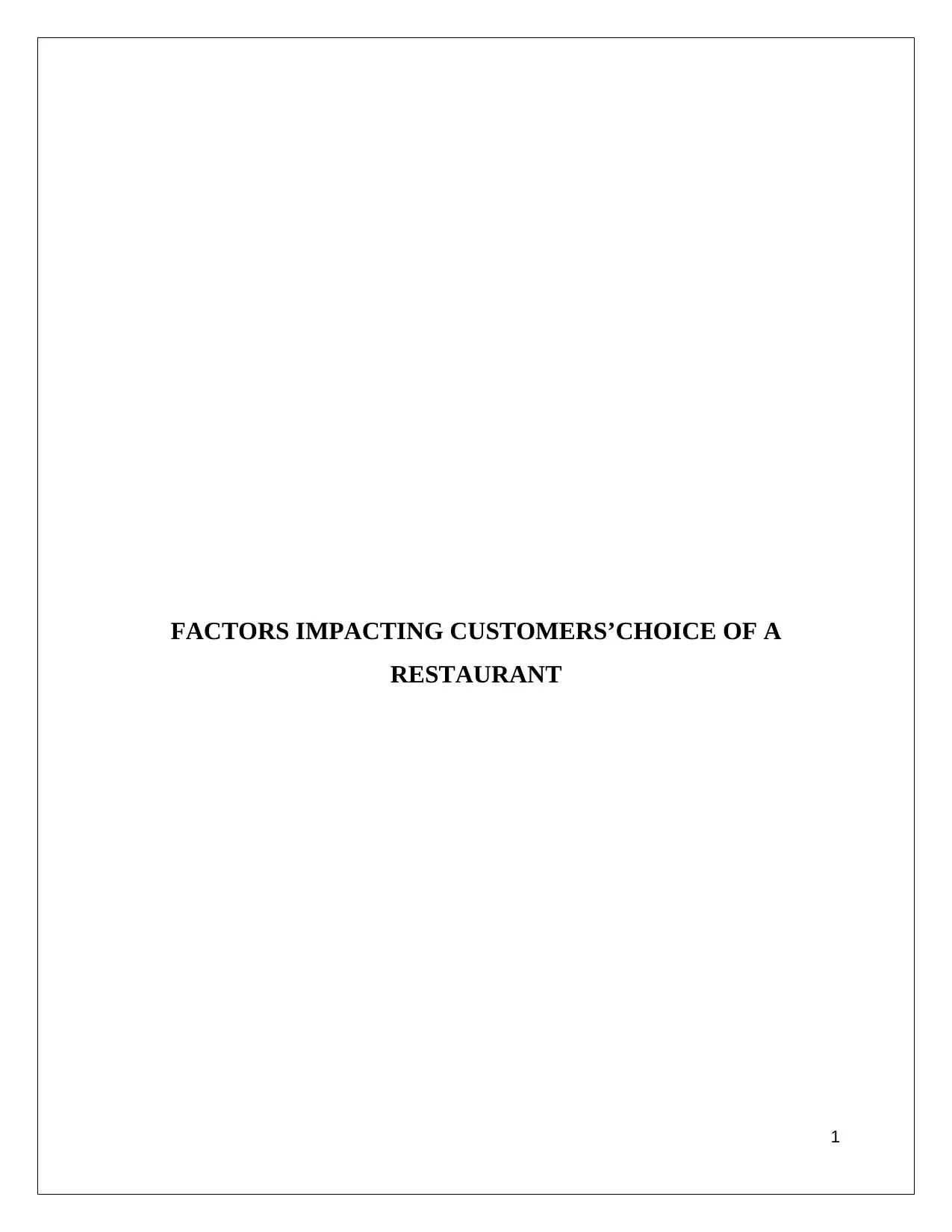
FACTORS IMPACTING CUSTOMERS’CHOICE OF A
RESTAURANT
1
RESTAURANT
1
Paraphrase This Document
Need a fresh take? Get an instant paraphrase of this document with our AI Paraphraser
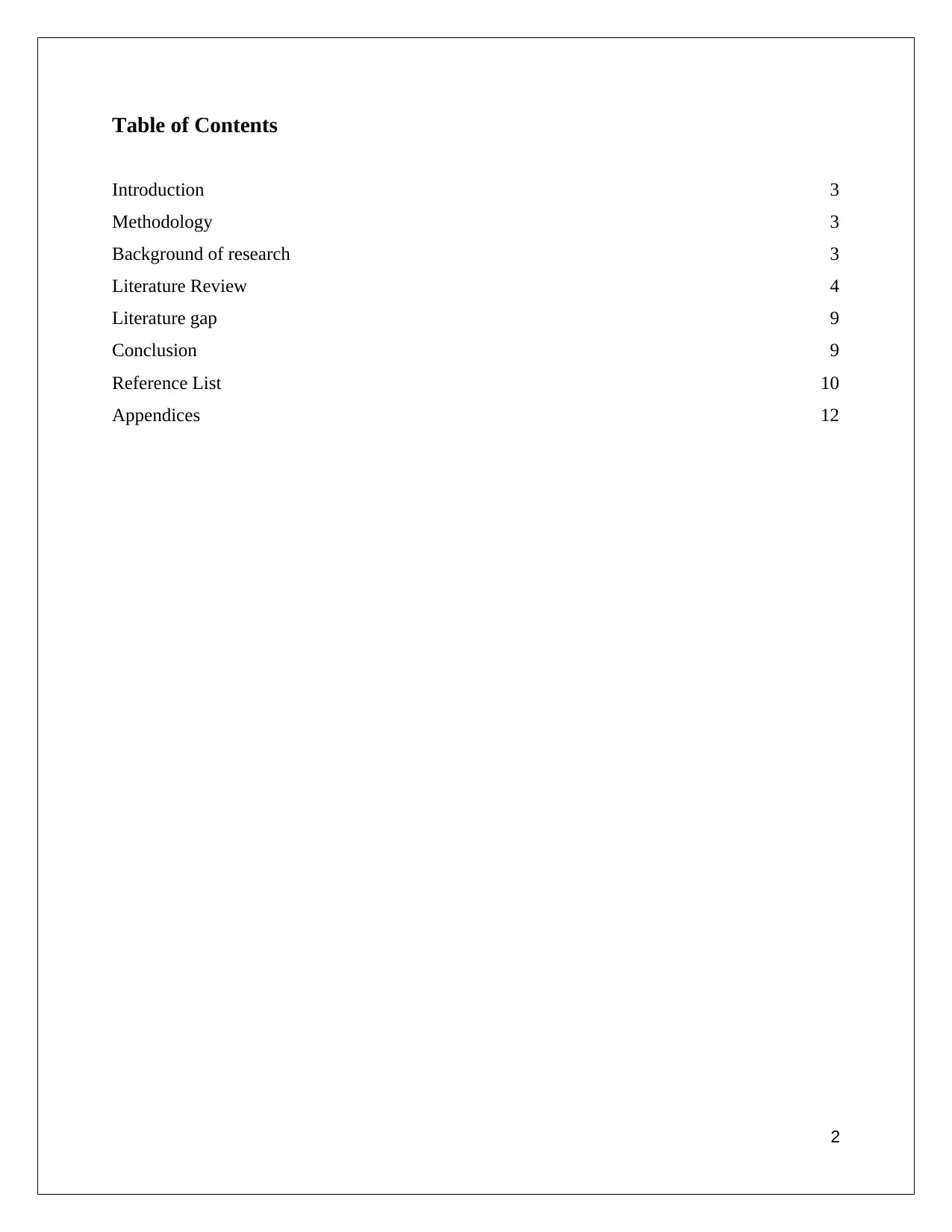
Table of Contents
Introduction 3
Methodology 3
Background of research 3
Literature Review 4
Literature gap 9
Conclusion 9
Reference List 10
Appendices 12
2
Introduction 3
Methodology 3
Background of research 3
Literature Review 4
Literature gap 9
Conclusion 9
Reference List 10
Appendices 12
2
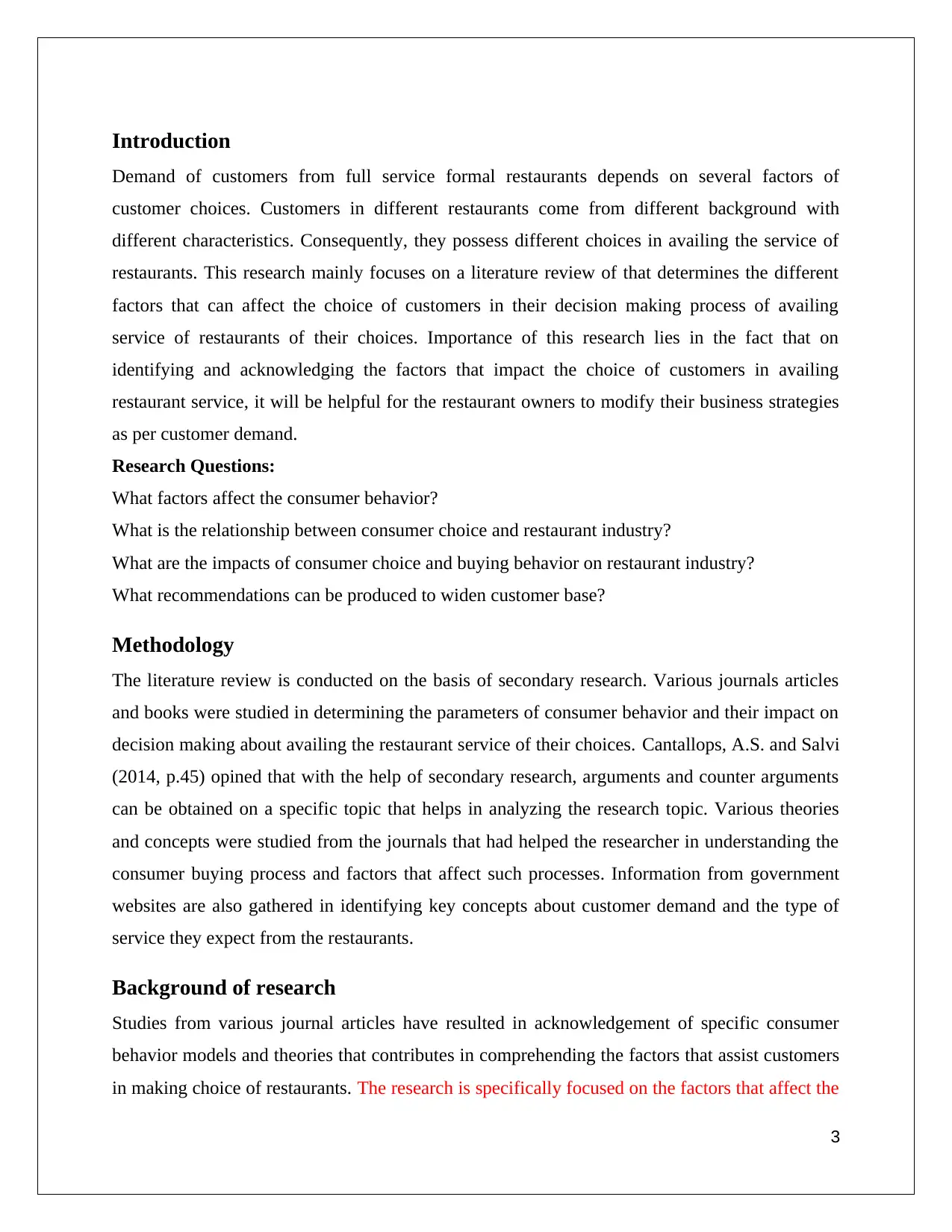
Introduction
Demand of customers from full service formal restaurants depends on several factors of
customer choices. Customers in different restaurants come from different background with
different characteristics. Consequently, they possess different choices in availing the service of
restaurants. This research mainly focuses on a literature review of that determines the different
factors that can affect the choice of customers in their decision making process of availing
service of restaurants of their choices. Importance of this research lies in the fact that on
identifying and acknowledging the factors that impact the choice of customers in availing
restaurant service, it will be helpful for the restaurant owners to modify their business strategies
as per customer demand.
Research Questions:
What factors affect the consumer behavior?
What is the relationship between consumer choice and restaurant industry?
What are the impacts of consumer choice and buying behavior on restaurant industry?
What recommendations can be produced to widen customer base?
Methodology
The literature review is conducted on the basis of secondary research. Various journals articles
and books were studied in determining the parameters of consumer behavior and their impact on
decision making about availing the restaurant service of their choices. Cantallops, A.S. and Salvi
(2014, p.45) opined that with the help of secondary research, arguments and counter arguments
can be obtained on a specific topic that helps in analyzing the research topic. Various theories
and concepts were studied from the journals that had helped the researcher in understanding the
consumer buying process and factors that affect such processes. Information from government
websites are also gathered in identifying key concepts about customer demand and the type of
service they expect from the restaurants.
Background of research
Studies from various journal articles have resulted in acknowledgement of specific consumer
behavior models and theories that contributes in comprehending the factors that assist customers
in making choice of restaurants. The research is specifically focused on the factors that affect the
3
Demand of customers from full service formal restaurants depends on several factors of
customer choices. Customers in different restaurants come from different background with
different characteristics. Consequently, they possess different choices in availing the service of
restaurants. This research mainly focuses on a literature review of that determines the different
factors that can affect the choice of customers in their decision making process of availing
service of restaurants of their choices. Importance of this research lies in the fact that on
identifying and acknowledging the factors that impact the choice of customers in availing
restaurant service, it will be helpful for the restaurant owners to modify their business strategies
as per customer demand.
Research Questions:
What factors affect the consumer behavior?
What is the relationship between consumer choice and restaurant industry?
What are the impacts of consumer choice and buying behavior on restaurant industry?
What recommendations can be produced to widen customer base?
Methodology
The literature review is conducted on the basis of secondary research. Various journals articles
and books were studied in determining the parameters of consumer behavior and their impact on
decision making about availing the restaurant service of their choices. Cantallops, A.S. and Salvi
(2014, p.45) opined that with the help of secondary research, arguments and counter arguments
can be obtained on a specific topic that helps in analyzing the research topic. Various theories
and concepts were studied from the journals that had helped the researcher in understanding the
consumer buying process and factors that affect such processes. Information from government
websites are also gathered in identifying key concepts about customer demand and the type of
service they expect from the restaurants.
Background of research
Studies from various journal articles have resulted in acknowledgement of specific consumer
behavior models and theories that contributes in comprehending the factors that assist customers
in making choice of restaurants. The research is specifically focused on the factors that affect the
3
⊘ This is a preview!⊘
Do you want full access?
Subscribe today to unlock all pages.

Trusted by 1+ million students worldwide

Theory of consumer behavior Theory of Reasoned action
Engel, Kollet, Blackwell Model
Intrinsic and Extrinsic factors Basic necessity of availing restaurant service
customer's choice of availing a restaurant service. It has been studied previously that quality of
food has a significant role in retaining customers in a restaurant. Theory of reasoned action is
included in the study for analysis of customer attitudes in their decision making process. On
counting the motivation need theory in depicting a customer behavior, it is possible to priorities
the needs of customers, once they avail the service of a restaurant.
Literature Review
Conceptual Framework
4
Engel, Kollet, Blackwell Model
Intrinsic and Extrinsic factors Basic necessity of availing restaurant service
customer's choice of availing a restaurant service. It has been studied previously that quality of
food has a significant role in retaining customers in a restaurant. Theory of reasoned action is
included in the study for analysis of customer attitudes in their decision making process. On
counting the motivation need theory in depicting a customer behavior, it is possible to priorities
the needs of customers, once they avail the service of a restaurant.
Literature Review
Conceptual Framework
4
Paraphrase This Document
Need a fresh take? Get an instant paraphrase of this document with our AI Paraphraser
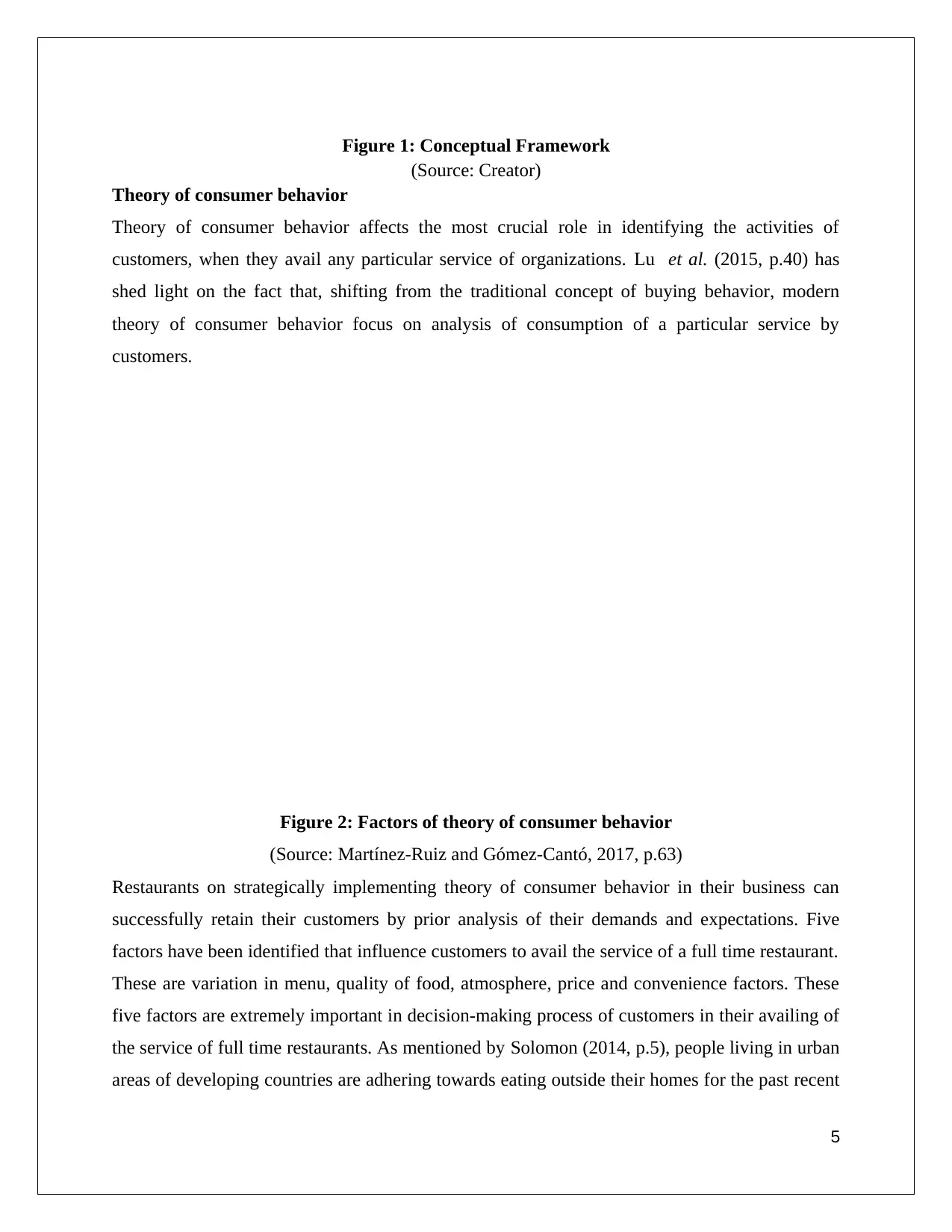
Figure 1: Conceptual Framework
(Source: Creator)
Theory of consumer behavior
Theory of consumer behavior affects the most crucial role in identifying the activities of
customers, when they avail any particular service of organizations. Lu et al. (2015, p.40) has
shed light on the fact that, shifting from the traditional concept of buying behavior, modern
theory of consumer behavior focus on analysis of consumption of a particular service by
customers.
Figure 2: Factors of theory of consumer behavior
(Source: Martínez-Ruiz and Gómez-Cantó, 2017, p.63)
Restaurants on strategically implementing theory of consumer behavior in their business can
successfully retain their customers by prior analysis of their demands and expectations. Five
factors have been identified that influence customers to avail the service of a full time restaurant.
These are variation in menu, quality of food, atmosphere, price and convenience factors. These
five factors are extremely important in decision-making process of customers in their availing of
the service of full time restaurants. As mentioned by Solomon (2014, p.5), people living in urban
areas of developing countries are adhering towards eating outside their homes for the past recent
5
MenuConvinienceFACTORSQualityoffoodAtmospherePrice
(Source: Creator)
Theory of consumer behavior
Theory of consumer behavior affects the most crucial role in identifying the activities of
customers, when they avail any particular service of organizations. Lu et al. (2015, p.40) has
shed light on the fact that, shifting from the traditional concept of buying behavior, modern
theory of consumer behavior focus on analysis of consumption of a particular service by
customers.
Figure 2: Factors of theory of consumer behavior
(Source: Martínez-Ruiz and Gómez-Cantó, 2017, p.63)
Restaurants on strategically implementing theory of consumer behavior in their business can
successfully retain their customers by prior analysis of their demands and expectations. Five
factors have been identified that influence customers to avail the service of a full time restaurant.
These are variation in menu, quality of food, atmosphere, price and convenience factors. These
five factors are extremely important in decision-making process of customers in their availing of
the service of full time restaurants. As mentioned by Solomon (2014, p.5), people living in urban
areas of developing countries are adhering towards eating outside their homes for the past recent
5
MenuConvinienceFACTORSQualityoffoodAtmospherePrice
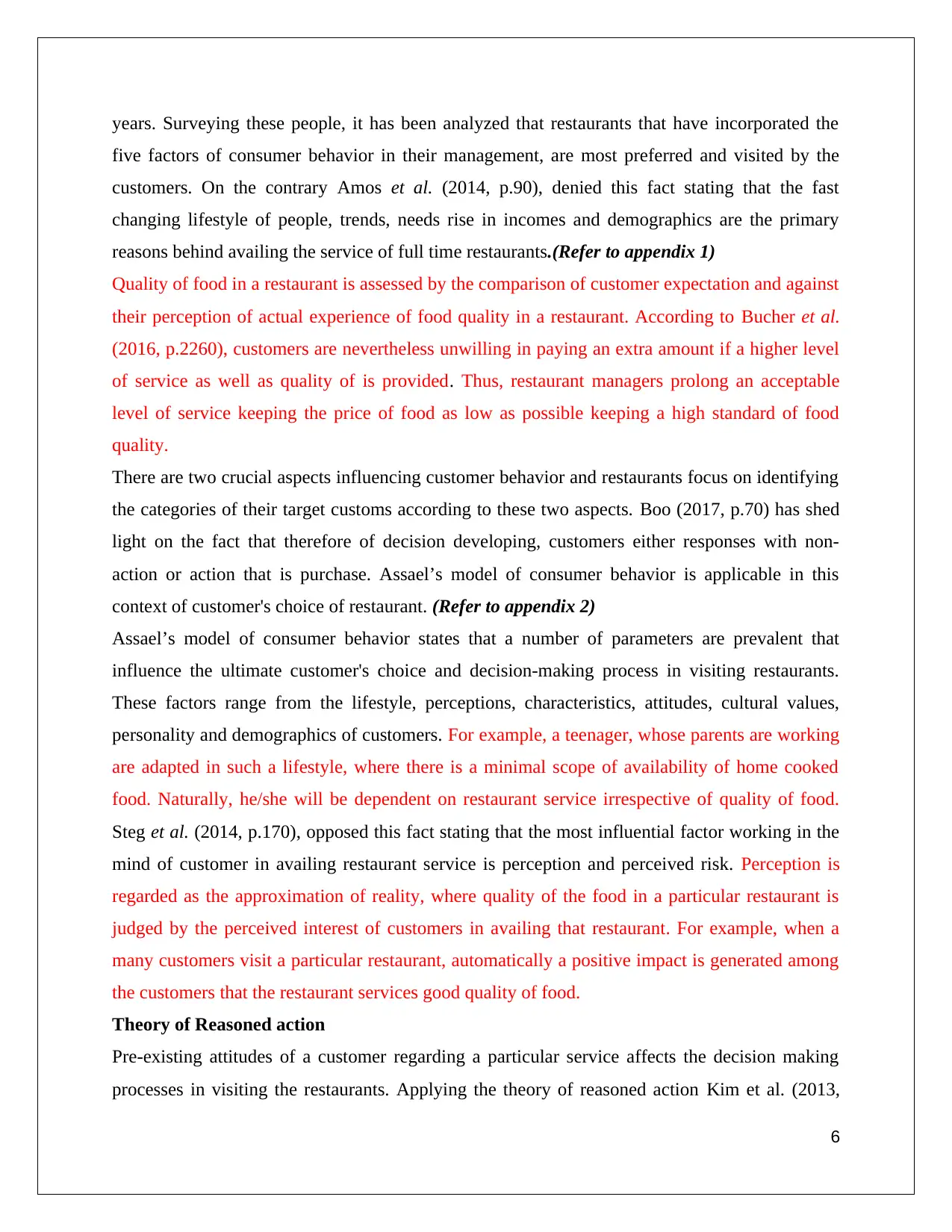
years. Surveying these people, it has been analyzed that restaurants that have incorporated the
five factors of consumer behavior in their management, are most preferred and visited by the
customers. On the contrary Amos et al. (2014, p.90), denied this fact stating that the fast
changing lifestyle of people, trends, needs rise in incomes and demographics are the primary
reasons behind availing the service of full time restaurants.(Refer to appendix 1)
Quality of food in a restaurant is assessed by the comparison of customer expectation and against
their perception of actual experience of food quality in a restaurant. According to Bucher et al.
(2016, p.2260), customers are nevertheless unwilling in paying an extra amount if a higher level
of service as well as quality of is provided. Thus, restaurant managers prolong an acceptable
level of service keeping the price of food as low as possible keeping a high standard of food
quality.
There are two crucial aspects influencing customer behavior and restaurants focus on identifying
the categories of their target customs according to these two aspects. Boo (2017, p.70) has shed
light on the fact that therefore of decision developing, customers either responses with non-
action or action that is purchase. Assael’s model of consumer behavior is applicable in this
context of customer's choice of restaurant. (Refer to appendix 2)
Assael’s model of consumer behavior states that a number of parameters are prevalent that
influence the ultimate customer's choice and decision-making process in visiting restaurants.
These factors range from the lifestyle, perceptions, characteristics, attitudes, cultural values,
personality and demographics of customers. For example, a teenager, whose parents are working
are adapted in such a lifestyle, where there is a minimal scope of availability of home cooked
food. Naturally, he/she will be dependent on restaurant service irrespective of quality of food.
Steg et al. (2014, p.170), opposed this fact stating that the most influential factor working in the
mind of customer in availing restaurant service is perception and perceived risk. Perception is
regarded as the approximation of reality, where quality of the food in a particular restaurant is
judged by the perceived interest of customers in availing that restaurant. For example, when a
many customers visit a particular restaurant, automatically a positive impact is generated among
the customers that the restaurant services good quality of food.
Theory of Reasoned action
Pre-existing attitudes of a customer regarding a particular service affects the decision making
processes in visiting the restaurants. Applying the theory of reasoned action Kim et al. (2013,
6
five factors of consumer behavior in their management, are most preferred and visited by the
customers. On the contrary Amos et al. (2014, p.90), denied this fact stating that the fast
changing lifestyle of people, trends, needs rise in incomes and demographics are the primary
reasons behind availing the service of full time restaurants.(Refer to appendix 1)
Quality of food in a restaurant is assessed by the comparison of customer expectation and against
their perception of actual experience of food quality in a restaurant. According to Bucher et al.
(2016, p.2260), customers are nevertheless unwilling in paying an extra amount if a higher level
of service as well as quality of is provided. Thus, restaurant managers prolong an acceptable
level of service keeping the price of food as low as possible keeping a high standard of food
quality.
There are two crucial aspects influencing customer behavior and restaurants focus on identifying
the categories of their target customs according to these two aspects. Boo (2017, p.70) has shed
light on the fact that therefore of decision developing, customers either responses with non-
action or action that is purchase. Assael’s model of consumer behavior is applicable in this
context of customer's choice of restaurant. (Refer to appendix 2)
Assael’s model of consumer behavior states that a number of parameters are prevalent that
influence the ultimate customer's choice and decision-making process in visiting restaurants.
These factors range from the lifestyle, perceptions, characteristics, attitudes, cultural values,
personality and demographics of customers. For example, a teenager, whose parents are working
are adapted in such a lifestyle, where there is a minimal scope of availability of home cooked
food. Naturally, he/she will be dependent on restaurant service irrespective of quality of food.
Steg et al. (2014, p.170), opposed this fact stating that the most influential factor working in the
mind of customer in availing restaurant service is perception and perceived risk. Perception is
regarded as the approximation of reality, where quality of the food in a particular restaurant is
judged by the perceived interest of customers in availing that restaurant. For example, when a
many customers visit a particular restaurant, automatically a positive impact is generated among
the customers that the restaurant services good quality of food.
Theory of Reasoned action
Pre-existing attitudes of a customer regarding a particular service affects the decision making
processes in visiting the restaurants. Applying the theory of reasoned action Kim et al. (2013,
6
⊘ This is a preview!⊘
Do you want full access?
Subscribe today to unlock all pages.

Trusted by 1+ million students worldwide
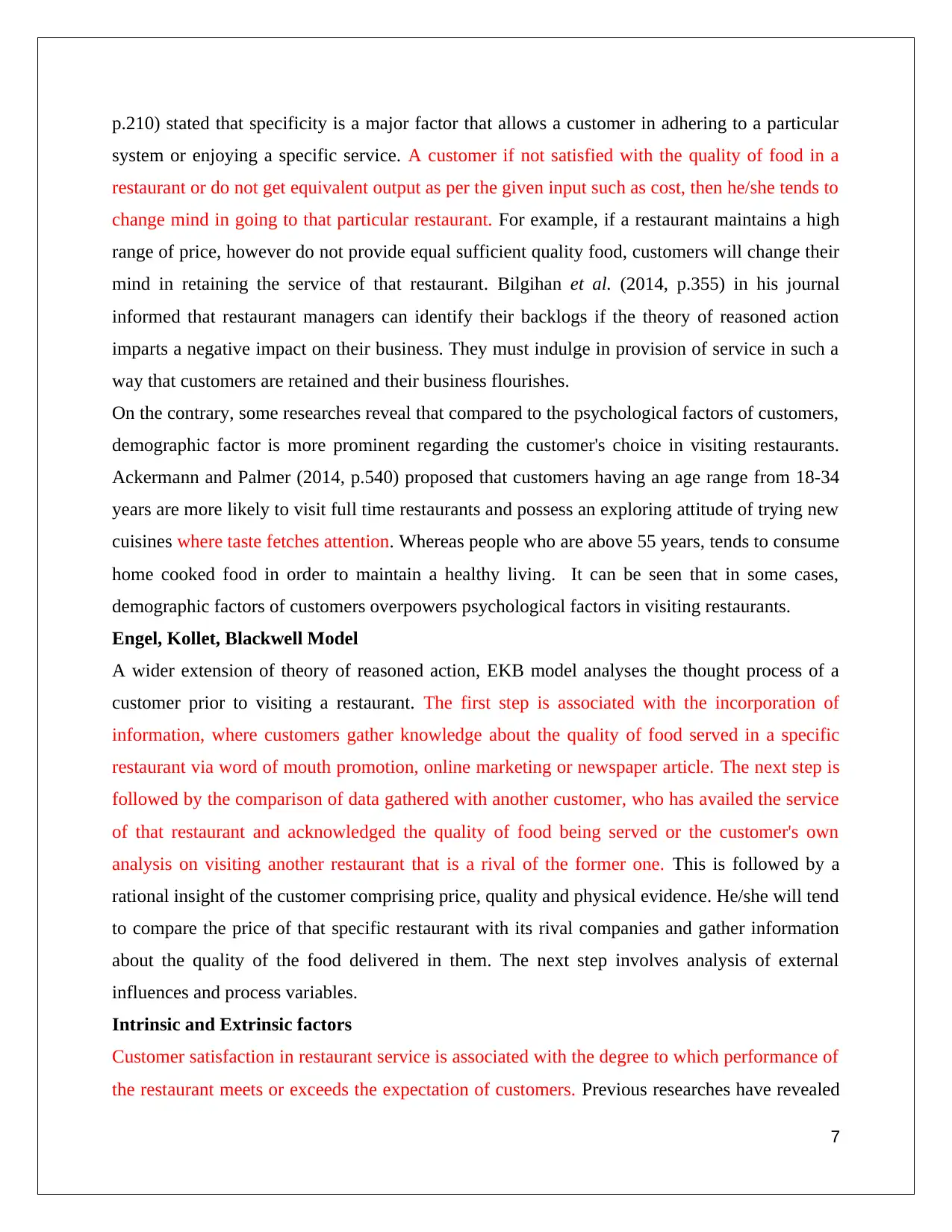
p.210) stated that specificity is a major factor that allows a customer in adhering to a particular
system or enjoying a specific service. A customer if not satisfied with the quality of food in a
restaurant or do not get equivalent output as per the given input such as cost, then he/she tends to
change mind in going to that particular restaurant. For example, if a restaurant maintains a high
range of price, however do not provide equal sufficient quality food, customers will change their
mind in retaining the service of that restaurant. Bilgihan et al. (2014, p.355) in his journal
informed that restaurant managers can identify their backlogs if the theory of reasoned action
imparts a negative impact on their business. They must indulge in provision of service in such a
way that customers are retained and their business flourishes.
On the contrary, some researches reveal that compared to the psychological factors of customers,
demographic factor is more prominent regarding the customer's choice in visiting restaurants.
Ackermann and Palmer (2014, p.540) proposed that customers having an age range from 18-34
years are more likely to visit full time restaurants and possess an exploring attitude of trying new
cuisines where taste fetches attention. Whereas people who are above 55 years, tends to consume
home cooked food in order to maintain a healthy living. It can be seen that in some cases,
demographic factors of customers overpowers psychological factors in visiting restaurants.
Engel, Kollet, Blackwell Model
A wider extension of theory of reasoned action, EKB model analyses the thought process of a
customer prior to visiting a restaurant. The first step is associated with the incorporation of
information, where customers gather knowledge about the quality of food served in a specific
restaurant via word of mouth promotion, online marketing or newspaper article. The next step is
followed by the comparison of data gathered with another customer, who has availed the service
of that restaurant and acknowledged the quality of food being served or the customer's own
analysis on visiting another restaurant that is a rival of the former one. This is followed by a
rational insight of the customer comprising price, quality and physical evidence. He/she will tend
to compare the price of that specific restaurant with its rival companies and gather information
about the quality of the food delivered in them. The next step involves analysis of external
influences and process variables.
Intrinsic and Extrinsic factors
Customer satisfaction in restaurant service is associated with the degree to which performance of
the restaurant meets or exceeds the expectation of customers. Previous researches have revealed
7
system or enjoying a specific service. A customer if not satisfied with the quality of food in a
restaurant or do not get equivalent output as per the given input such as cost, then he/she tends to
change mind in going to that particular restaurant. For example, if a restaurant maintains a high
range of price, however do not provide equal sufficient quality food, customers will change their
mind in retaining the service of that restaurant. Bilgihan et al. (2014, p.355) in his journal
informed that restaurant managers can identify their backlogs if the theory of reasoned action
imparts a negative impact on their business. They must indulge in provision of service in such a
way that customers are retained and their business flourishes.
On the contrary, some researches reveal that compared to the psychological factors of customers,
demographic factor is more prominent regarding the customer's choice in visiting restaurants.
Ackermann and Palmer (2014, p.540) proposed that customers having an age range from 18-34
years are more likely to visit full time restaurants and possess an exploring attitude of trying new
cuisines where taste fetches attention. Whereas people who are above 55 years, tends to consume
home cooked food in order to maintain a healthy living. It can be seen that in some cases,
demographic factors of customers overpowers psychological factors in visiting restaurants.
Engel, Kollet, Blackwell Model
A wider extension of theory of reasoned action, EKB model analyses the thought process of a
customer prior to visiting a restaurant. The first step is associated with the incorporation of
information, where customers gather knowledge about the quality of food served in a specific
restaurant via word of mouth promotion, online marketing or newspaper article. The next step is
followed by the comparison of data gathered with another customer, who has availed the service
of that restaurant and acknowledged the quality of food being served or the customer's own
analysis on visiting another restaurant that is a rival of the former one. This is followed by a
rational insight of the customer comprising price, quality and physical evidence. He/she will tend
to compare the price of that specific restaurant with its rival companies and gather information
about the quality of the food delivered in them. The next step involves analysis of external
influences and process variables.
Intrinsic and Extrinsic factors
Customer satisfaction in restaurant service is associated with the degree to which performance of
the restaurant meets or exceeds the expectation of customers. Previous researches have revealed
7
Paraphrase This Document
Need a fresh take? Get an instant paraphrase of this document with our AI Paraphraser
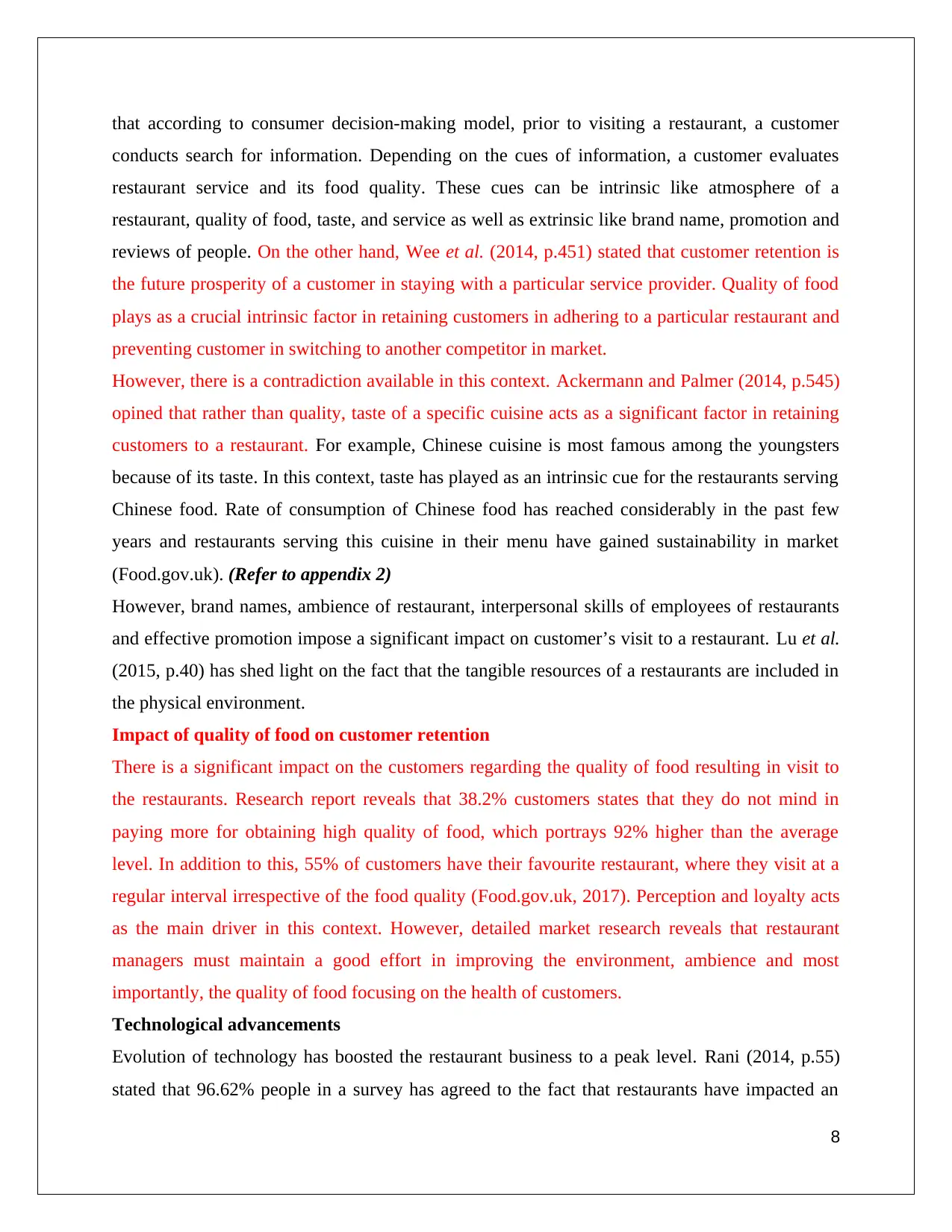
that according to consumer decision-making model, prior to visiting a restaurant, a customer
conducts search for information. Depending on the cues of information, a customer evaluates
restaurant service and its food quality. These cues can be intrinsic like atmosphere of a
restaurant, quality of food, taste, and service as well as extrinsic like brand name, promotion and
reviews of people. On the other hand, Wee et al. (2014, p.451) stated that customer retention is
the future prosperity of a customer in staying with a particular service provider. Quality of food
plays as a crucial intrinsic factor in retaining customers in adhering to a particular restaurant and
preventing customer in switching to another competitor in market.
However, there is a contradiction available in this context. Ackermann and Palmer (2014, p.545)
opined that rather than quality, taste of a specific cuisine acts as a significant factor in retaining
customers to a restaurant. For example, Chinese cuisine is most famous among the youngsters
because of its taste. In this context, taste has played as an intrinsic cue for the restaurants serving
Chinese food. Rate of consumption of Chinese food has reached considerably in the past few
years and restaurants serving this cuisine in their menu have gained sustainability in market
(Food.gov.uk). (Refer to appendix 2)
However, brand names, ambience of restaurant, interpersonal skills of employees of restaurants
and effective promotion impose a significant impact on customer’s visit to a restaurant. Lu et al.
(2015, p.40) has shed light on the fact that the tangible resources of a restaurants are included in
the physical environment.
Impact of quality of food on customer retention
There is a significant impact on the customers regarding the quality of food resulting in visit to
the restaurants. Research report reveals that 38.2% customers states that they do not mind in
paying more for obtaining high quality of food, which portrays 92% higher than the average
level. In addition to this, 55% of customers have their favourite restaurant, where they visit at a
regular interval irrespective of the food quality (Food.gov.uk, 2017). Perception and loyalty acts
as the main driver in this context. However, detailed market research reveals that restaurant
managers must maintain a good effort in improving the environment, ambience and most
importantly, the quality of food focusing on the health of customers.
Technological advancements
Evolution of technology has boosted the restaurant business to a peak level. Rani (2014, p.55)
stated that 96.62% people in a survey has agreed to the fact that restaurants have impacted an
8
conducts search for information. Depending on the cues of information, a customer evaluates
restaurant service and its food quality. These cues can be intrinsic like atmosphere of a
restaurant, quality of food, taste, and service as well as extrinsic like brand name, promotion and
reviews of people. On the other hand, Wee et al. (2014, p.451) stated that customer retention is
the future prosperity of a customer in staying with a particular service provider. Quality of food
plays as a crucial intrinsic factor in retaining customers in adhering to a particular restaurant and
preventing customer in switching to another competitor in market.
However, there is a contradiction available in this context. Ackermann and Palmer (2014, p.545)
opined that rather than quality, taste of a specific cuisine acts as a significant factor in retaining
customers to a restaurant. For example, Chinese cuisine is most famous among the youngsters
because of its taste. In this context, taste has played as an intrinsic cue for the restaurants serving
Chinese food. Rate of consumption of Chinese food has reached considerably in the past few
years and restaurants serving this cuisine in their menu have gained sustainability in market
(Food.gov.uk). (Refer to appendix 2)
However, brand names, ambience of restaurant, interpersonal skills of employees of restaurants
and effective promotion impose a significant impact on customer’s visit to a restaurant. Lu et al.
(2015, p.40) has shed light on the fact that the tangible resources of a restaurants are included in
the physical environment.
Impact of quality of food on customer retention
There is a significant impact on the customers regarding the quality of food resulting in visit to
the restaurants. Research report reveals that 38.2% customers states that they do not mind in
paying more for obtaining high quality of food, which portrays 92% higher than the average
level. In addition to this, 55% of customers have their favourite restaurant, where they visit at a
regular interval irrespective of the food quality (Food.gov.uk, 2017). Perception and loyalty acts
as the main driver in this context. However, detailed market research reveals that restaurant
managers must maintain a good effort in improving the environment, ambience and most
importantly, the quality of food focusing on the health of customers.
Technological advancements
Evolution of technology has boosted the restaurant business to a peak level. Rani (2014, p.55)
stated that 96.62% people in a survey has agreed to the fact that restaurants have impacted an
8
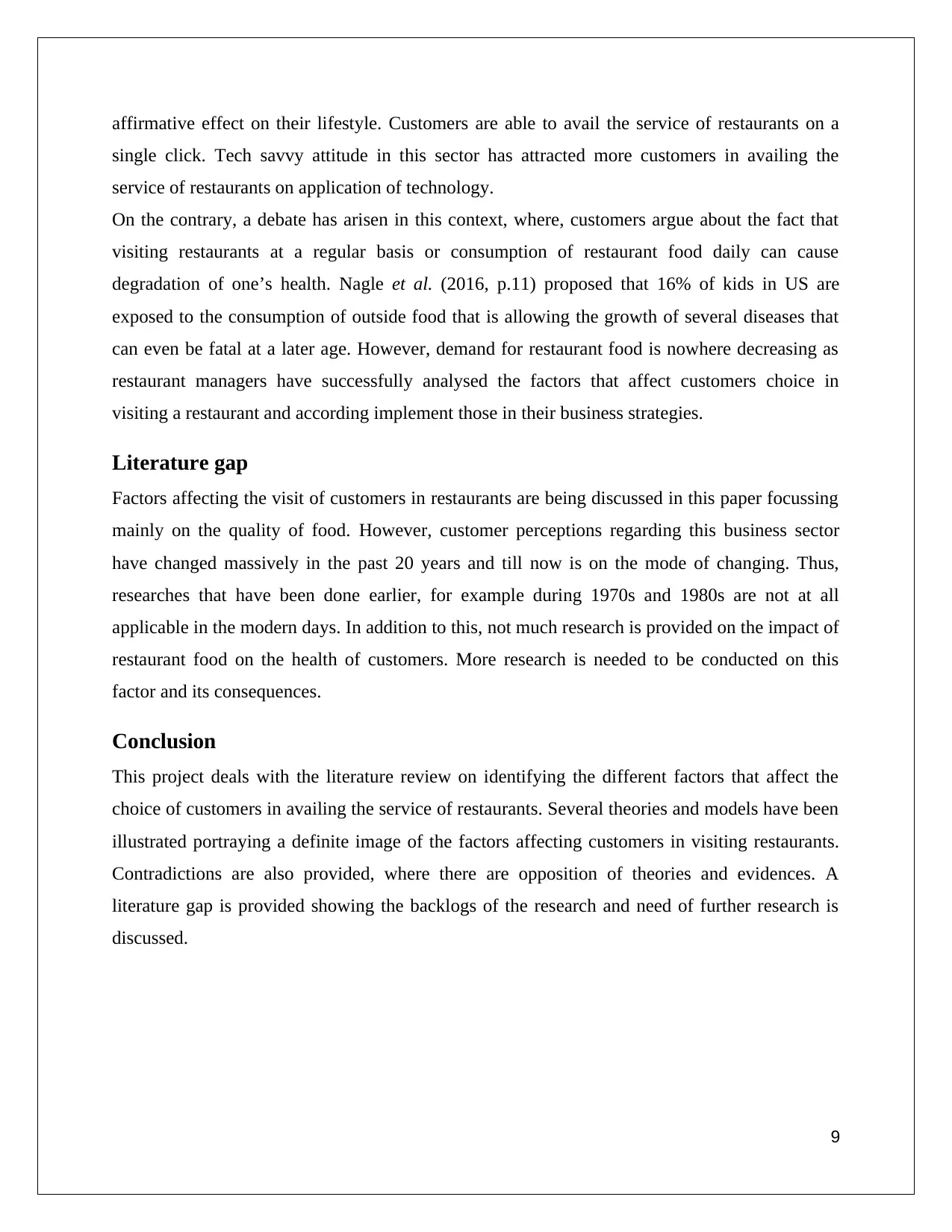
affirmative effect on their lifestyle. Customers are able to avail the service of restaurants on a
single click. Tech savvy attitude in this sector has attracted more customers in availing the
service of restaurants on application of technology.
On the contrary, a debate has arisen in this context, where, customers argue about the fact that
visiting restaurants at a regular basis or consumption of restaurant food daily can cause
degradation of one’s health. Nagle et al. (2016, p.11) proposed that 16% of kids in US are
exposed to the consumption of outside food that is allowing the growth of several diseases that
can even be fatal at a later age. However, demand for restaurant food is nowhere decreasing as
restaurant managers have successfully analysed the factors that affect customers choice in
visiting a restaurant and according implement those in their business strategies.
Literature gap
Factors affecting the visit of customers in restaurants are being discussed in this paper focussing
mainly on the quality of food. However, customer perceptions regarding this business sector
have changed massively in the past 20 years and till now is on the mode of changing. Thus,
researches that have been done earlier, for example during 1970s and 1980s are not at all
applicable in the modern days. In addition to this, not much research is provided on the impact of
restaurant food on the health of customers. More research is needed to be conducted on this
factor and its consequences.
Conclusion
This project deals with the literature review on identifying the different factors that affect the
choice of customers in availing the service of restaurants. Several theories and models have been
illustrated portraying a definite image of the factors affecting customers in visiting restaurants.
Contradictions are also provided, where there are opposition of theories and evidences. A
literature gap is provided showing the backlogs of the research and need of further research is
discussed.
9
single click. Tech savvy attitude in this sector has attracted more customers in availing the
service of restaurants on application of technology.
On the contrary, a debate has arisen in this context, where, customers argue about the fact that
visiting restaurants at a regular basis or consumption of restaurant food daily can cause
degradation of one’s health. Nagle et al. (2016, p.11) proposed that 16% of kids in US are
exposed to the consumption of outside food that is allowing the growth of several diseases that
can even be fatal at a later age. However, demand for restaurant food is nowhere decreasing as
restaurant managers have successfully analysed the factors that affect customers choice in
visiting a restaurant and according implement those in their business strategies.
Literature gap
Factors affecting the visit of customers in restaurants are being discussed in this paper focussing
mainly on the quality of food. However, customer perceptions regarding this business sector
have changed massively in the past 20 years and till now is on the mode of changing. Thus,
researches that have been done earlier, for example during 1970s and 1980s are not at all
applicable in the modern days. In addition to this, not much research is provided on the impact of
restaurant food on the health of customers. More research is needed to be conducted on this
factor and its consequences.
Conclusion
This project deals with the literature review on identifying the different factors that affect the
choice of customers in availing the service of restaurants. Several theories and models have been
illustrated portraying a definite image of the factors affecting customers in visiting restaurants.
Contradictions are also provided, where there are opposition of theories and evidences. A
literature gap is provided showing the backlogs of the research and need of further research is
discussed.
9
⊘ This is a preview!⊘
Do you want full access?
Subscribe today to unlock all pages.

Trusted by 1+ million students worldwide
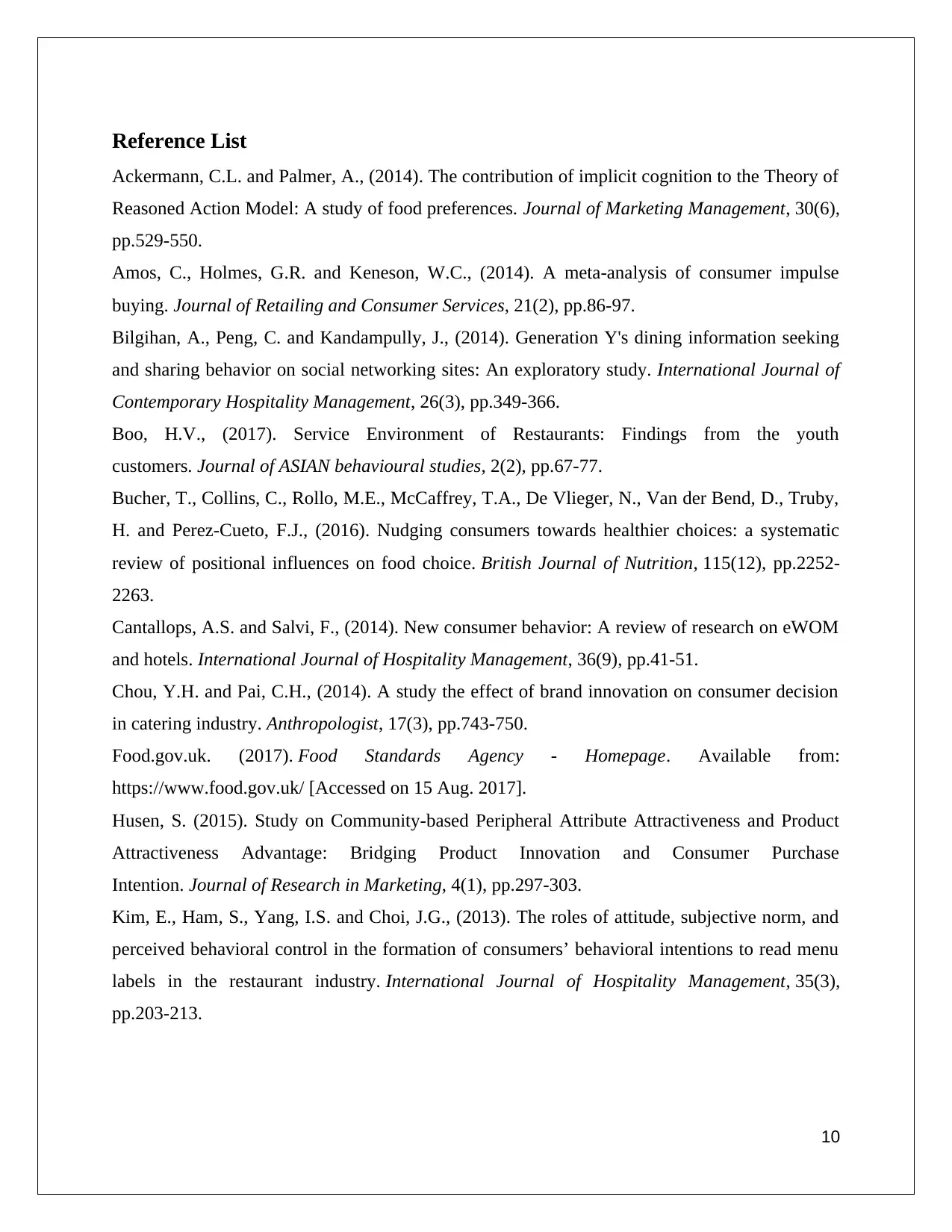
Reference List
Ackermann, C.L. and Palmer, A., (2014). The contribution of implicit cognition to the Theory of
Reasoned Action Model: A study of food preferences. Journal of Marketing Management, 30(6),
pp.529-550.
Amos, C., Holmes, G.R. and Keneson, W.C., (2014). A meta-analysis of consumer impulse
buying. Journal of Retailing and Consumer Services, 21(2), pp.86-97.
Bilgihan, A., Peng, C. and Kandampully, J., (2014). Generation Y's dining information seeking
and sharing behavior on social networking sites: An exploratory study. International Journal of
Contemporary Hospitality Management, 26(3), pp.349-366.
Boo, H.V., (2017). Service Environment of Restaurants: Findings from the youth
customers. Journal of ASIAN behavioural studies, 2(2), pp.67-77.
Bucher, T., Collins, C., Rollo, M.E., McCaffrey, T.A., De Vlieger, N., Van der Bend, D., Truby,
H. and Perez-Cueto, F.J., (2016). Nudging consumers towards healthier choices: a systematic
review of positional influences on food choice. British Journal of Nutrition, 115(12), pp.2252-
2263.
Cantallops, A.S. and Salvi, F., (2014). New consumer behavior: A review of research on eWOM
and hotels. International Journal of Hospitality Management, 36(9), pp.41-51.
Chou, Y.H. and Pai, C.H., (2014). A study the effect of brand innovation on consumer decision
in catering industry. Anthropologist, 17(3), pp.743-750.
Food.gov.uk. (2017). Food Standards Agency - Homepage. Available from:
https://www.food.gov.uk/ [Accessed on 15 Aug. 2017].
Husen, S. (2015). Study on Community-based Peripheral Attribute Attractiveness and Product
Attractiveness Advantage: Bridging Product Innovation and Consumer Purchase
Intention. Journal of Research in Marketing, 4(1), pp.297-303.
Kim, E., Ham, S., Yang, I.S. and Choi, J.G., (2013). The roles of attitude, subjective norm, and
perceived behavioral control in the formation of consumers’ behavioral intentions to read menu
labels in the restaurant industry. International Journal of Hospitality Management, 35(3),
pp.203-213.
10
Ackermann, C.L. and Palmer, A., (2014). The contribution of implicit cognition to the Theory of
Reasoned Action Model: A study of food preferences. Journal of Marketing Management, 30(6),
pp.529-550.
Amos, C., Holmes, G.R. and Keneson, W.C., (2014). A meta-analysis of consumer impulse
buying. Journal of Retailing and Consumer Services, 21(2), pp.86-97.
Bilgihan, A., Peng, C. and Kandampully, J., (2014). Generation Y's dining information seeking
and sharing behavior on social networking sites: An exploratory study. International Journal of
Contemporary Hospitality Management, 26(3), pp.349-366.
Boo, H.V., (2017). Service Environment of Restaurants: Findings from the youth
customers. Journal of ASIAN behavioural studies, 2(2), pp.67-77.
Bucher, T., Collins, C., Rollo, M.E., McCaffrey, T.A., De Vlieger, N., Van der Bend, D., Truby,
H. and Perez-Cueto, F.J., (2016). Nudging consumers towards healthier choices: a systematic
review of positional influences on food choice. British Journal of Nutrition, 115(12), pp.2252-
2263.
Cantallops, A.S. and Salvi, F., (2014). New consumer behavior: A review of research on eWOM
and hotels. International Journal of Hospitality Management, 36(9), pp.41-51.
Chou, Y.H. and Pai, C.H., (2014). A study the effect of brand innovation on consumer decision
in catering industry. Anthropologist, 17(3), pp.743-750.
Food.gov.uk. (2017). Food Standards Agency - Homepage. Available from:
https://www.food.gov.uk/ [Accessed on 15 Aug. 2017].
Husen, S. (2015). Study on Community-based Peripheral Attribute Attractiveness and Product
Attractiveness Advantage: Bridging Product Innovation and Consumer Purchase
Intention. Journal of Research in Marketing, 4(1), pp.297-303.
Kim, E., Ham, S., Yang, I.S. and Choi, J.G., (2013). The roles of attitude, subjective norm, and
perceived behavioral control in the formation of consumers’ behavioral intentions to read menu
labels in the restaurant industry. International Journal of Hospitality Management, 35(3),
pp.203-213.
10
Paraphrase This Document
Need a fresh take? Get an instant paraphrase of this document with our AI Paraphraser

Kim, Y.J., Njite, D. and Hancer, M., (2013). Anticipated emotion in consumers’ intentions to
select eco-friendly restaurants: Augmenting the theory of planned behavior. International
Journal of Hospitality Management, 34(3), pp.255-262.
Li, H., Jiang, J. and Wu, M., (2014). The effects of trust assurances on consumers’ initial online
trust: A two-stage decision-making process perspective. International Journal of Information
Management, 34(3), pp.395-405.
Lu, A.C.C., Gursoy, D. and Lu, C.Y., (2015). Authenticity perceptions, brand equity and brand
choice intention: The case of ethnic restaurants. International Journal of Hospitality
Management, 50(1), pp.36-45.
Martínez-Ruiz, M. and Gómez-Cantó, C. (2017). Key External Influences Affecting Consumers’
Decisions Regarding Food. ncbi.nlm.nih.gov. Available from:
https://www.ncbi.nlm.nih.gov/pmc/articles/PMC5067376/ [Accessed on 11 Aug. 2017].
Nagle, T.T., Hogan, J. and Zale, J., (2016). The Strategy and Tactics of Pricing: New
International Edition. Abingdon: Routledge.
Rani, P., (2014). Factors influencing consumer behaviour. International journal of current
research and academic review, 2(9), pp.52-61.
Solomon, M.R., (2014). Consumer behavior: Buying, having, and being, New Jersey: Prentice
Hall.
Steg, L., Perlaviciute, G., Van der Werff, E. and Lurvink, J., (2014). The significance of hedonic
values for environmentally relevant attitudes, preferences, and actions. Environment and
behavior, 46(2), pp.163-192.
Wales, M. (2017). Understanding the role of convenience in consumer food choices: a review
article. Journal.lib.uoguelph.ca. Available from:
https://journal.lib.uoguelph.ca/index.php/surg/article/view/983/1431 [Accessed on12 Aug. 2017].
Wee, C.S., Ariff, M.S.B.M., Zakuan, N., Tajudin, M.N.M., Ismail, K. and Ishak, N., (2014).
Consumers perception, purchase intention and actual purchase behavior of organic food
products. Review of Integrative Business and Economics Research, 3(2), pp.378-532.
11
select eco-friendly restaurants: Augmenting the theory of planned behavior. International
Journal of Hospitality Management, 34(3), pp.255-262.
Li, H., Jiang, J. and Wu, M., (2014). The effects of trust assurances on consumers’ initial online
trust: A two-stage decision-making process perspective. International Journal of Information
Management, 34(3), pp.395-405.
Lu, A.C.C., Gursoy, D. and Lu, C.Y., (2015). Authenticity perceptions, brand equity and brand
choice intention: The case of ethnic restaurants. International Journal of Hospitality
Management, 50(1), pp.36-45.
Martínez-Ruiz, M. and Gómez-Cantó, C. (2017). Key External Influences Affecting Consumers’
Decisions Regarding Food. ncbi.nlm.nih.gov. Available from:
https://www.ncbi.nlm.nih.gov/pmc/articles/PMC5067376/ [Accessed on 11 Aug. 2017].
Nagle, T.T., Hogan, J. and Zale, J., (2016). The Strategy and Tactics of Pricing: New
International Edition. Abingdon: Routledge.
Rani, P., (2014). Factors influencing consumer behaviour. International journal of current
research and academic review, 2(9), pp.52-61.
Solomon, M.R., (2014). Consumer behavior: Buying, having, and being, New Jersey: Prentice
Hall.
Steg, L., Perlaviciute, G., Van der Werff, E. and Lurvink, J., (2014). The significance of hedonic
values for environmentally relevant attitudes, preferences, and actions. Environment and
behavior, 46(2), pp.163-192.
Wales, M. (2017). Understanding the role of convenience in consumer food choices: a review
article. Journal.lib.uoguelph.ca. Available from:
https://journal.lib.uoguelph.ca/index.php/surg/article/view/983/1431 [Accessed on12 Aug. 2017].
Wee, C.S., Ariff, M.S.B.M., Zakuan, N., Tajudin, M.N.M., Ismail, K. and Ishak, N., (2014).
Consumers perception, purchase intention and actual purchase behavior of organic food
products. Review of Integrative Business and Economics Research, 3(2), pp.378-532.
11
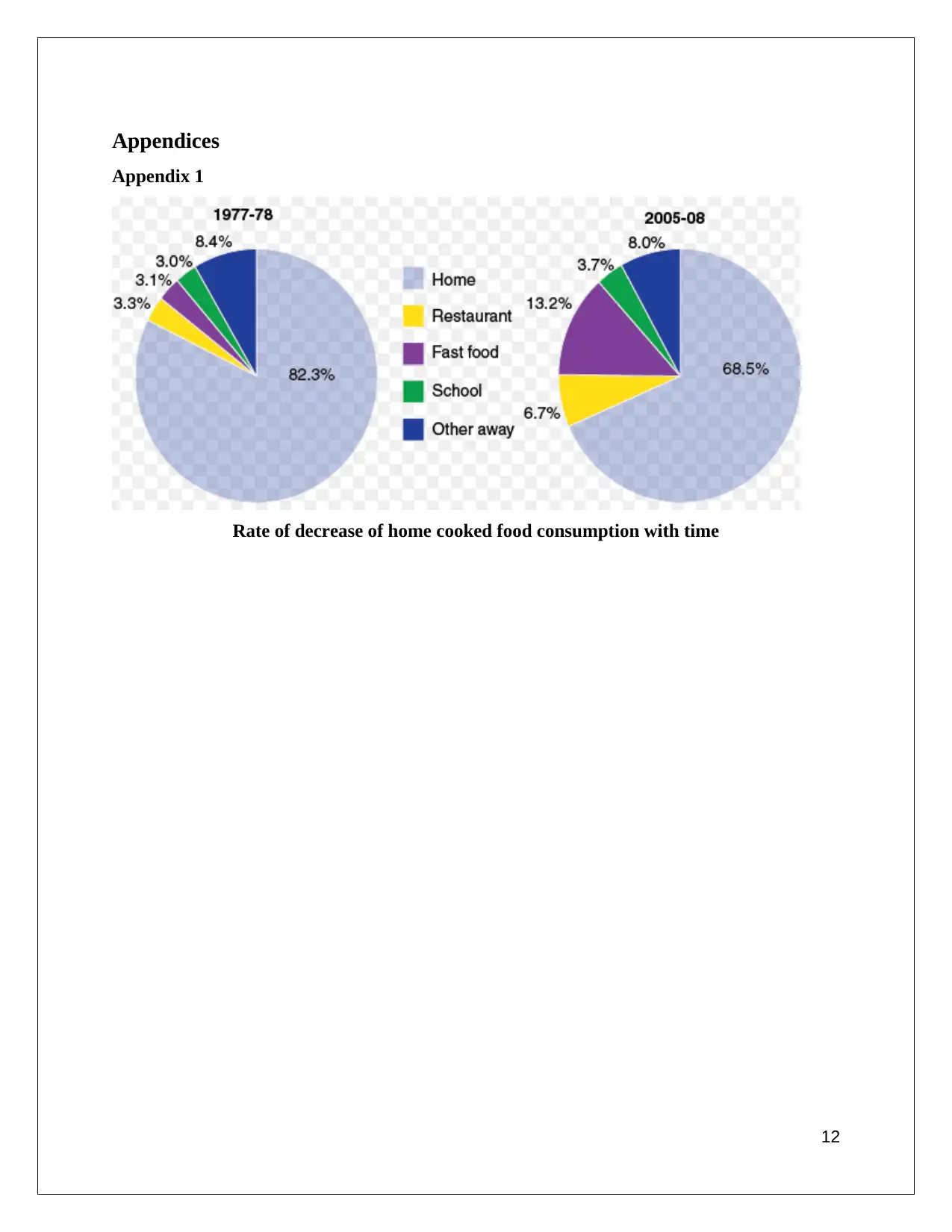
Appendices
Appendix 1
Rate of decrease of home cooked food consumption with time
12
Appendix 1
Rate of decrease of home cooked food consumption with time
12
⊘ This is a preview!⊘
Do you want full access?
Subscribe today to unlock all pages.

Trusted by 1+ million students worldwide
1 out of 14
Related Documents
Your All-in-One AI-Powered Toolkit for Academic Success.
+13062052269
info@desklib.com
Available 24*7 on WhatsApp / Email
![[object Object]](/_next/static/media/star-bottom.7253800d.svg)
Unlock your academic potential
Copyright © 2020–2025 A2Z Services. All Rights Reserved. Developed and managed by ZUCOL.




